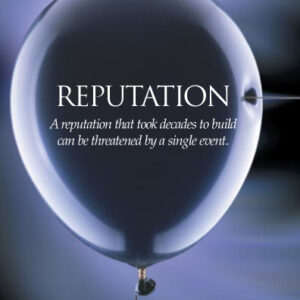Perception vs. Reality: How to Rebuild a Reputation

How many times have we heard the adage that perception is reality? In the world of public relations, this is a phrase and a reality that we deal with a lot.
I was recently in Mexico, a country I have visited many times, for a mini vacation over Thanksgiving break. As we were checking out of the hotel, the front desk person handed us a letter. It started out by thanking us for our stay at the hotel, and went on to cover the difficult times that Mexico is experiencing along its U. S. border cities, some 2,019 miles away. The letter described tourism as Mexico’s leading sources of employment and how potential travelers are having second thoughts about visiting Mexico, which of course hurts the thousands of people who work in the hotels and other tourism-related industries. The last part of the letter was a call to action asking us to talk to our friends, families, colleagues, local media and using social media to share our positive experience in Mexico. “This will surely help dispel some of the negative press talking and wrong perceptions that damage tourism in our country,” the letter stated.
The letter reminded me of an article I’d recently read in Newsweek titled “Tourism Come On In, the Water’s Fine – Never mind the beheadings, the kidnappings, the mass graves. Mexico wants its tourists back.” The article included an interview with Mexico’s tourism secretary who thinks her country has nothing more than a PR problem. In the case of Mexico, perception to many is the reality.
It’s common knowledge that an organization or individual’s reputation that is built over many years or a lifetime can be destroyed in an instant. Penn State is the most recent example. However quickly reputations are destroyed, Americans are forgiving people and believe in second chances (think of our celebrities who fall from grace only to be lauded a year later).
Are we as forgiving of businesses that mess up? Think BP or Goldman Sachs? Or is it better to disappear (Enron), be acquired (Arthur Anderson) or just change your name (Valu Jet)? What can a business or organization do when it has fallen from grace? How are reputations restored? One of the first steps is to consider hiring public relations counsel to help guide the company or organization and provide a critical outsider’s perspective. Following are some of the additional steps to help rebuild a damaged reputation.
•
Acknowledge and Accept Responsibility: Identify what the root causes are of the damage and acknowledge them. This is the time that the company or organization needs to admit the mistakes and be transparent.
•
Plan and Implement Changes: Put a plan in motion to fix whatever the issues were that led to the crisis in the first place. Actions speak louder than words, so depending on what the crisis was, rebuilding reputations could take months or years.
•
Engage with target audiences/key stakeholders: Be proactive with target audiences by sharing the details of what the company or organization has done and how the changes will help to ensure that mistakes aren’t repeated. By involving stakeholders in the rebuilding process, this can help to rebuild trust and repair damaged relationships.
There is no silver bullet or shortcuts when it comes to restoring a damaged reputation and rebuilding public trust. It requires thoughtful planning and execution, patience and always “doing the right thing” for target audiences and stakeholders. There are many examples of companies or organizations that have successfully rebuilt reputations, and just as many examples of ones that never recovered because they ignored their publics and were unwilling to take the appropriate steps.
 How many times have we heard the adage that perception is reality? In the world of public relations, this is a phrase and a reality that we deal with a lot.
I was recently in Mexico, a country I have visited many times, for a mini vacation over Thanksgiving break. As we were checking out of the hotel, the front desk person handed us a letter. It started out by thanking us for our stay at the hotel, and went on to cover the difficult times that Mexico is experiencing along its U. S. border cities, some 2,019 miles away. The letter described tourism as Mexico’s leading sources of employment and how potential travelers are having second thoughts about visiting Mexico, which of course hurts the thousands of people who work in the hotels and other tourism-related industries. The last part of the letter was a call to action asking us to talk to our friends, families, colleagues, local media and using social media to share our positive experience in Mexico. “This will surely help dispel some of the negative press talking and wrong perceptions that damage tourism in our country,” the letter stated.
The letter reminded me of an article I’d recently read in Newsweek titled “Tourism Come On In, the Water’s Fine – Never mind the beheadings, the kidnappings, the mass graves. Mexico wants its tourists back.” The article included an interview with Mexico’s tourism secretary who thinks her country has nothing more than a PR problem. In the case of Mexico, perception to many is the reality.
It’s common knowledge that an organization or individual’s reputation that is built over many years or a lifetime can be destroyed in an instant. Penn State is the most recent example. However quickly reputations are destroyed, Americans are forgiving people and believe in second chances (think of our celebrities who fall from grace only to be lauded a year later).
Are we as forgiving of businesses that mess up? Think BP or Goldman Sachs? Or is it better to disappear (Enron), be acquired (Arthur Anderson) or just change your name (Valu Jet)? What can a business or organization do when it has fallen from grace? How are reputations restored? One of the first steps is to consider hiring public relations counsel to help guide the company or organization and provide a critical outsider’s perspective. Following are some of the additional steps to help rebuild a damaged reputation.
• Acknowledge and Accept Responsibility: Identify what the root causes are of the damage and acknowledge them. This is the time that the company or organization needs to admit the mistakes and be transparent.
• Plan and Implement Changes: Put a plan in motion to fix whatever the issues were that led to the crisis in the first place. Actions speak louder than words, so depending on what the crisis was, rebuilding reputations could take months or years.
• Engage with target audiences/key stakeholders: Be proactive with target audiences by sharing the details of what the company or organization has done and how the changes will help to ensure that mistakes aren’t repeated. By involving stakeholders in the rebuilding process, this can help to rebuild trust and repair damaged relationships.
There is no silver bullet or shortcuts when it comes to restoring a damaged reputation and rebuilding public trust. It requires thoughtful planning and execution, patience and always “doing the right thing” for target audiences and stakeholders. There are many examples of companies or organizations that have successfully rebuilt reputations, and just as many examples of ones that never recovered because they ignored their publics and were unwilling to take the appropriate steps.
How many times have we heard the adage that perception is reality? In the world of public relations, this is a phrase and a reality that we deal with a lot.
I was recently in Mexico, a country I have visited many times, for a mini vacation over Thanksgiving break. As we were checking out of the hotel, the front desk person handed us a letter. It started out by thanking us for our stay at the hotel, and went on to cover the difficult times that Mexico is experiencing along its U. S. border cities, some 2,019 miles away. The letter described tourism as Mexico’s leading sources of employment and how potential travelers are having second thoughts about visiting Mexico, which of course hurts the thousands of people who work in the hotels and other tourism-related industries. The last part of the letter was a call to action asking us to talk to our friends, families, colleagues, local media and using social media to share our positive experience in Mexico. “This will surely help dispel some of the negative press talking and wrong perceptions that damage tourism in our country,” the letter stated.
The letter reminded me of an article I’d recently read in Newsweek titled “Tourism Come On In, the Water’s Fine – Never mind the beheadings, the kidnappings, the mass graves. Mexico wants its tourists back.” The article included an interview with Mexico’s tourism secretary who thinks her country has nothing more than a PR problem. In the case of Mexico, perception to many is the reality.
It’s common knowledge that an organization or individual’s reputation that is built over many years or a lifetime can be destroyed in an instant. Penn State is the most recent example. However quickly reputations are destroyed, Americans are forgiving people and believe in second chances (think of our celebrities who fall from grace only to be lauded a year later).
Are we as forgiving of businesses that mess up? Think BP or Goldman Sachs? Or is it better to disappear (Enron), be acquired (Arthur Anderson) or just change your name (Valu Jet)? What can a business or organization do when it has fallen from grace? How are reputations restored? One of the first steps is to consider hiring public relations counsel to help guide the company or organization and provide a critical outsider’s perspective. Following are some of the additional steps to help rebuild a damaged reputation.
• Acknowledge and Accept Responsibility: Identify what the root causes are of the damage and acknowledge them. This is the time that the company or organization needs to admit the mistakes and be transparent.
• Plan and Implement Changes: Put a plan in motion to fix whatever the issues were that led to the crisis in the first place. Actions speak louder than words, so depending on what the crisis was, rebuilding reputations could take months or years.
• Engage with target audiences/key stakeholders: Be proactive with target audiences by sharing the details of what the company or organization has done and how the changes will help to ensure that mistakes aren’t repeated. By involving stakeholders in the rebuilding process, this can help to rebuild trust and repair damaged relationships.
There is no silver bullet or shortcuts when it comes to restoring a damaged reputation and rebuilding public trust. It requires thoughtful planning and execution, patience and always “doing the right thing” for target audiences and stakeholders. There are many examples of companies or organizations that have successfully rebuilt reputations, and just as many examples of ones that never recovered because they ignored their publics and were unwilling to take the appropriate steps.



